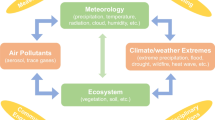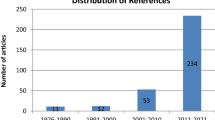Abstract
Microphysical measurements of orographic fog were performed above a montane cloud forest in northeastern Taiwan (Chilan mountain site). The measured parameters include droplet size distribution (DSD), absolute humidity (AH), relative humidity (RH), air temperature, wind speed and direction, visibility, and solar short wave radiation. The scope of this work was to study the short term variations of DSD, temperature, and RH, with a temporal resolution of 3 Hz. The results show that orographic fog is randomly composed of various air volumes that are intrinsically rather homogeneous, but exhibit clear differences between each other with respect to their size, RH, LWC, and DSD. Three general types of air volumes have been identified via the recorded DSD. A statistical analysis of the characteristics of these volumes yielded large variabilities in persistence, RH, and LWC. Further, the data revealed an inverse relation between RH and LWC. In principle, this finding can be explained by the condensational growth theory for droplets containing soluble or insoluble material. Droplets with greater diameters can exist at lower ambient RH than smaller ones. However, condensational growth alone is not capable to explain the large observed differences in DSD and RH because the respective growth speeds are too slow to explain the observed phenomena. Other mechanisms play key roles as well. Possible processes leading to the large observed differences in RH and DSD include turbulence induced collision and coalescence, and heterogeneous mixing. More analyses including fog droplet chemistry and dynamic microphysical modeling are required to further study these processes. To our knowledge, this is the first experimental field observation of the anti-correlation between RH and LWC in fog.






Similar content being viewed by others
References
Alduchov, O.A., and Eskridge, R.E. (1996), Improved magnus form approximation of saturation vapor pressure, Journal of Applied Meteorology 35, 601–609.
Baldocchi, D., Falge, E., Gu, L.H., Olson, R., Hollinger, D., Running, S., Anthoni, P., Bernhofer, C., Davis, K., Evans, R., Fuentes, J., Goldstein, A., Katul, G., Law, B., Lee, X.H., Malhi, Y., Meyers, T., Munger, W., Oechel, W., U, K.T.P., Pilegaard, K., Schmid, H.P., Valentini, R., Verma, S., Vesala, T., Wilson, K., and Wofsy, S. (2001), FLUXNET: a new tool to study the temporal and spatial variability of ecosystem-scale carbon dioxide, water vapor, and energy flux densities, Bulletin of the American Meteorological Society 82, 2415–2434.
Beiderwieden, E., Wolff, V., Hsia, Y.J., and Klemm, O. (2008), It goes both ways: measurements of simultaneous evapotranspiration and fog droplet deposition at a montane cloud forest, Hydrological Processes 22, 4181–4189.
Best, A.C. (1951), The Size of Cloud Droplets in Layer-Type Cloud, Quarterly Journal of the Royal Meteorological Society 77, 241–248.
Cerni, T.A. (1994), An Infrared Hygrometer for Atmospheric Research and Routine Monitoring, Journal of Atmospheric and Oceanic Technology 11, 445–462.
Chang, S.C., Lai, I.L., and Wu, J.T. (2002), Estimation of fog deposition on epiphytic bryophytes in a subtropical montane forest ecosystem in northeastern Taiwan, Atmospheric Research 64, 159–167.
Chang, S.C., Yeh, C.F., Wu, M.J., Hsia, Y.J., and Wu, J.T. (2006), Quantifying fog water deposition by in situ exposure experiments in a mountainous coniferous forest in Taiwan, Forest Ecology and Management 224, 11–18.
Elting, D., Theoretische Meteorologie: Eine Einführung (Berlin: Springer, 2008).
Eugster, W., Burkard, R., Holwerda, F., Scatena, F.N., and Bruijnzeel, L.A.S. (2006), Characteristics of fog and fogwater fluxes in a Puerto Rican elfin cloud forest, Agricultural and Forest Meteorology 139, 288–306.
Garcia-Garcia, F., Virafuentes, U., and Montero-Martinez, G. (2002), Fine-scale measurements of fog-droplet concentrations: a preliminary assessment, Atmospheric Research 64, 179–189.
Gerber, H.E. (1980), A Saturation Hygrometer for the Measurement of Relative-Humidity between 95-Percent and 105-Percent, Journal of Applied Meteorology 19, 1196–1208.
Gerber, H.E. (1991), Supersaturation and Droplet Spectral Evolution in Fog, Journal of the Atmospheric Sciences 48, 2569–2588.
Gultepe, I., Tardif, R., Michaelides, S.C., Cermak, J., Bott, A., Bendix, J., Muller, M.D., Pagowski, M., Hansen, B., Ellrod, G., Jacobs, W., Toth, G., and Cober, S.G. (2007), Fog research: A review of past achievements and future perspectives, Pure and Applied Geophysics 164, 1121–1159.
Köhler, H. (1921), Zur Kondensation des Wasserdampfes in der Atmosphäre, Geofys. Publ. 2, 3–15.
Michel, B. (2007), MieCalc—freely configurable program for light scattering calculations (Mie theory), http://www.lightscattering.de/MieCalc/eindex.html.
Mie, G. (1908), Beiträge der Optik trüber Medien, speziell kolloidaler Metallösungen, Annalen der Physik 4, 377–445.
Pilié, R.J., Mack, E.J., Kocmond, W.C., Eadie, W.J., and Rogers, C.W. (1975), Life-Cycle of Valley Fog .2. Fog Microphysics, Journal of Applied Meteorology 14, 364–374.
Pruppacher, H.R., and Klett, J.D., Microphysics of clouds and precipitation, (Boston: Kluwer Academic Publishers, 1997).
Rogers, R. R., and Yau, M. K., A short course in cloud physics, (Oxford: Pergamon Press, 1989).
Savitzky, A., and Golay, M.J.E. (1964), Smoothing + Differentiation of Data by Simplified Least Squares Procedures, Analytical Chemistry 36, 1627–1639.
Schmidt, E., and Grigull, U., Properties of water and steam in SI-units : thermodynamische Eigenschaften von Wasser und Wasserdampf : 0-800 p0 sC, 0-1000 bar, (Berlin: Springer, 1979).
Sonntag, D. (1990), Important new values of the physical constants of 1986, vapor pressure formulations based in ITS-90, and psychrometer formulae, Zeitschrift Fur Meteorologie 70, 340–344.
Wallace, J.M., and Hobbs, P.V., Atmospheric science : an introductory survey, (Boston: Elsevier Academic Press, 2006).
Weisensee, U., and Leps, J.-P. (2002), Fast-Response, open path optical Hygrometer for long-term measurements—Experiences, results, future requirements, Deutscher Wetterdienst, Meteorologisches Observatorium Lindenberg.
Acknowledgments
This study was supported by the German Academic Exchange Service DAAD through the PPP program. We thank D. Baumgardner, H.M. Chung, T. El-Madany, Y.T. Jian, J.Y. Jiang, C.W. Lai, M.C. Li, J.Y. Lin, T.Y. Lin, P. Sulmann, C.P. Wang, T. Wolf, and C.C. Wu for help and advice in the field experiment and during data analysis. We gratefully acknowledge L. Harris for language editing of the manuscript.
Author information
Authors and Affiliations
Corresponding author
Rights and permissions
About this article
Cite this article
Gonser, S.G., Klemm, O., Griessbaum, F. et al. The Relation Between Humidity and Liquid Water Content in Fog: An Experimental Approach. Pure Appl. Geophys. 169, 821–833 (2012). https://doi.org/10.1007/s00024-011-0270-x
Received:
Revised:
Accepted:
Published:
Issue Date:
DOI: https://doi.org/10.1007/s00024-011-0270-x




